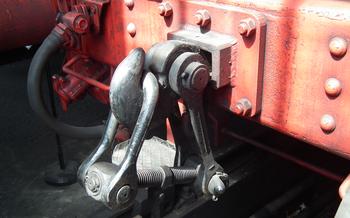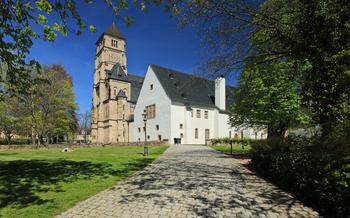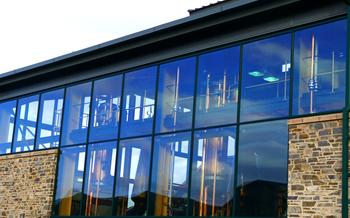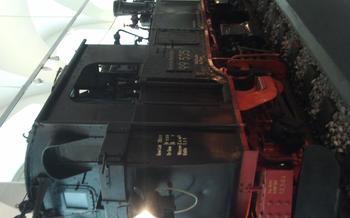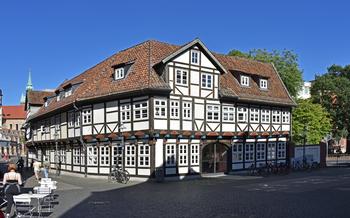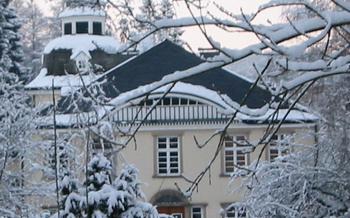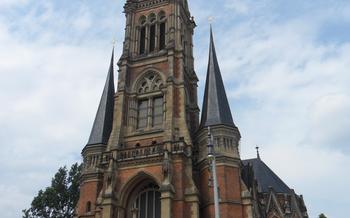
Sächsisches Eisenbahnmuseum
- History of the Museum
- Exhibits and Collections: A Journey Through Railway History
- Interactive Displays
- Historical Context
- Guided Tours
- Special Events and Exhibitions
- Museum Shop and Souvenirs
- Accessibility and Facilities: Creating an Inclusive and Welcoming Space for All
- Location and Transportation
- Opening Hours and Admission Fees
- Photography and Videography
- Educational Programs: Engaging with Railway History and Science
- Volunteering and Internships
- Research and Publications
- Insider Tip: A Glimpse into the Past
History of the Museum
The Sächsisches Eisenbahnmuseum in Chemnitz, Germany, is a fascinating journey through the annals of railway history. Established in 1976, the museum occupies a prominent place in the city's rich railway heritage. Chemnitz, a significant railway hub in Saxony, was chosen as the ideal location to showcase the evolution of railway technology and its impact on society. The museum's extensive collection, coupled with its commitment to preserving and presenting railway history, makes it a must-visit destination for enthusiasts and casual visitors alike.
Exhibits and Collections: A Journey Through Railway History
The Sächsisches Eisenbahnmuseum in Chemnitz boasts an extensive and diverse collection of locomotives, wagons, and railway artifacts that tell the captivating story of railway technology's evolution. Among the notable exhibits are magnificent steam engines that once thundered across the tracks, evoking the romance and nostalgia of a bygone era. Diesel locomotives, symbols of the transition to modern traction, stand side by side with their electric counterparts, representing the future of railway transportation. The museum's collection is not merely a display of machines; it is a testament to human ingenuity, engineering prowess, and the transformative power of railways in shaping societies and economies. Each exhibit carries a unique tale of innovation, challenges overcome, and the relentless pursuit of progress that has defined the history of railways.
Interactive Displays
The Sächsisches Eisenbahnmuseum offers a range of interactive exhibits and educational displays that bring the history and technology of railways to life. Visitors can explore the inner workings of locomotives through cutaway models and transparent panels, providing a glimpse into the complex machinery that powers these iron horses. Interactive displays allow visitors to operate signals, control switches, and even drive a virtual train, offering a hands-on experience of railway operations. Educational panels provide in-depth information on the history of railway technology, the evolution of locomotives, and the role of railways in shaping modern society. These interactive elements enhance the visitor experience, making the museum not just a place of observation but also an engaging learning environment. Whether you're a railway enthusiast or simply curious about the world of trains, the Sächsisches Eisenbahnmuseum offers a captivating and interactive journey through the history of this transformative technology.
Historical Context
The development of railways in Germany is intertwined with the industrial revolution and the rise of Chemnitz as a major industrial and transportation hub. In the late 19th century, Chemnitz became a crucial railway junction, connecting major cities and facilitating the transport of goods and people. The city's favorable location and thriving industries made it a natural choice for establishing a museum dedicated to preserving and showcasing the history of railway technology.
The Sächsisches Eisenbahnmuseum serves as a testament to the significant role that railways played in shaping Germany's industrial landscape. Its collection reflects the evolution of railway technology from the early days of steam engines to the modern era of electric and diesel locomotives. Visitors can trace the development of railway engineering and marvel at the ingenuity and innovation that drove the transformation of transportation. The museum also highlights the impact of railways on society, industry, and urban development, providing a fascinating glimpse into a pivotal era in German history.
Guided Tours
The Sächsisches Eisenbahnmuseum offers guided tours in German and English, providing visitors with an immersive and informative experience. These tours are led by knowledgeable docents who share their expertise and insights on the museum's exhibits and the history of railways in Germany.
During the guided tours, visitors can gain a deeper understanding of the functioning of locomotives and railway systems, as well as the historical context in which they were developed. Docents provide detailed explanations of the exhibits, answering questions and pointing out interesting features that might otherwise go unnoticed.
Guided tours are available at specific times throughout the day, and visitors can book their preferred time slot in advance to avoid disappointment. The duration of the tours varies depending on the size of the group and the level of interest, but typically lasts around 60 to 90 minutes.
Whether you are a railway enthusiast, a history buff, or simply curious about the world of trains, a guided tour of the Sächsisches Eisenbahnmuseum is a highly recommended experience.
Special Events and Exhibitions
To keep the museum's exhibits fresh and engaging for visitors, special events, temporary exhibitions, and themed displays are held throughout the year. These special events offer a unique opportunity for visitors to delve deeper into the world of railways and explore specific aspects of railway history and technology.
Temporary exhibitions often focus on specific themes or topics related to railways, such as the evolution of locomotive design, the role of railways in wartime, or the impact of railways on society and culture. These exhibitions showcase rare artifacts, documents, and photographs that are not usually on display, providing visitors with a unique perspective on railway history.
Themed displays, on the other hand, are smaller-scale exhibitions that highlight specific aspects of the museum's collection or showcase new acquisitions. These displays often feature interactive elements, hands-on activities, or multimedia presentations that engage visitors and provide a deeper understanding of railway technology and operations.
By hosting these special events and exhibitions, the Sächsisches Eisenbahnmuseum aims to keep its exhibits fresh and exciting for repeat visitors. It also provides a platform for railway enthusiasts, historians, and researchers to share their knowledge and insights with the public, fostering a deeper appreciation for the rich history of railways in Germany.
Museum Shop and Souvenirs
As you exit the fascinating world of railway history, don't miss the opportunity to visit the museum shop, where you can take home a piece of your experience. The shop is a treasure trove of railway-themed souvenirs and memorabilia that will serve as lasting reminders of your visit.
From books and magazines that delve into the intricate details of railway history to intricate model trains and toys that bring the magic of the rails to life, the museum shop has something for every railway enthusiast. You'll find an array of items to choose from, including scale models of locomotives and carriages, plush toys depicting iconic railway characters, and a variety of books and DVDs that explore the fascinating world of railways.
Whether you're looking for a unique gift for a fellow railway buff or a special keepsake for yourself, the museum shop offers a wide range of options to suit every taste and budget. So, take a moment to browse the shelves and discover the perfect souvenir to commemorate your visit to the Sächsisches Eisenbahnmuseum.
Accessibility and Facilities: Creating an Inclusive and Welcoming Space for All
The Sächsisches Eisenbahnmuseum is committed to providing a welcoming and accessible experience for all visitors. The museum is wheelchair accessible, with ramps and elevators ensuring that all exhibits are easily reachable. Visitors with disabilities can also take advantage of reserved parking spaces located close to the museum entrance.
For the convenience of visitors, the museum offers a range of facilities to enhance their experience. Restrooms are available within the museum, and a cafeteria provides refreshments and light meals. Lockers or a cloakroom are available for visitors to store their belongings securely while exploring the exhibits.
The museum staff is always willing to assist visitors with any needs or questions they may have. Visitors are encouraged to approach the friendly and knowledgeable staff for directions, information about the exhibits, or any other assistance they may require.
Location and Transportation
The Sächsisches Eisenbahnmuseum is conveniently situated within Chemnitz, a city easily accessible by various modes of transportation. Visitors can take advantage of the city's public transportation network, with tram and bus lines stopping nearby. Detailed schedules and route information are readily available online or at local transportation hubs.
For those arriving by car, the museum offers ample parking spaces, ensuring a hassle-free visit. Parking fees may apply, but visitors can inquire about discounted rates or special parking arrangements for museum guests.
Chemnitz's central location makes it an ideal starting point for exploring the region. Visitors can combine their museum visit with other attractions in the city, such as the Chemnitz Art Collections, the Red Tower, or the Chemnitz Opera House.
For those seeking alternative transportation options, bike rentals are available in the city, allowing visitors to explore Chemnitz's green spaces and bike paths. Taxis are also readily accessible, providing a convenient way to navigate the city and its surroundings.
Opening Hours and Admission Fees
The Sächsisches Eisenbahnmuseum in Chemnitz is open to the public Tuesday through Sunday, with varying hours depending on the season. During the summer months (April to October), the museum is open from 10:00 AM to 6:00 PM, while in the winter months (November to March), the hours are 10:00 AM to 4:00 PM. The museum is closed on Mondays and on certain public holidays. Admission fees are reasonable, with adults paying 8 euros, children aged 6 to 17 paying 4 euros, and children under 6 admitted free of charge. Family tickets and group discounts are also available. Tickets can be purchased at the museum's ticket counter or online through the museum's website.
Photography and Videography
The Sächsisches Eisenbahnmuseum welcomes visitors to capture their memories through photography and videography within the exhibits. However, to ensure the preservation of the collection and the comfort of other visitors, certain guidelines must be followed. Flash photography is prohibited to prevent damage to the delicate artifacts. Tripods and other photography equipment are generally allowed, but their use may be restricted in certain areas to avoid obstructing walkways or exhibits. Visitors are encouraged to be respectful of other guests and avoid disrupting their experience while taking photos or videos. For professional photographers or videographers seeking to conduct extensive photography or filming, special permissions and bookings may be arranged with the museum's management.
Educational Programs: Engaging with Railway History and Science
The Sächsisches Eisenbahnmuseum offers a range of educational programs and workshops designed to engage school groups, families, and individuals with the fascinating world of railways. These programs aim to foster a deeper understanding of railway history, science, and technology, inspiring future generations of railway enthusiasts.
The museum's educational team has developed interactive and immersive programs that bring railway heritage to life. School groups can participate in guided tours tailored to their curriculum, exploring the museum's collection and learning about the development of railways in Germany. Families can enjoy hands-on activities and workshops that allow children to build their own locomotives or experiment with model trains. Individual visitors can join themed workshops or lectures that delve into specific aspects of railway history or technology.
Through these educational programs, the museum strives to create a space where visitors of all ages can learn, explore, and discover the wonders of railways. Whether it's understanding the mechanics of a steam engine, tracing the evolution of railway networks, or simply marveling at the ingenuity of railway engineering, the Sächsisches Eisenbahnmuseum provides a rich and educational experience for all.
Volunteering and Internships
The Sächsisches Eisenbahnmuseum offers exciting volunteer opportunities for individuals who share a passion for railways and heritage preservation. By joining the museum's volunteer team, you can gain valuable hands-on experience in various aspects of railway operations, restoration, and education. Volunteers have the chance to work alongside experienced professionals, learn from experts in the field, and contribute directly to the museum's mission of preserving and showcasing railway history.
Whether you're a railway enthusiast, a history buff, or simply looking for a meaningful and engaging volunteer experience, the Sächsisches Eisenbahnmuseum welcomes individuals from all backgrounds. Volunteers can get involved in a variety of tasks, such as assisting with museum operations, guiding visitors, conducting research, or helping with restoration projects. By becoming a volunteer, you'll not only gain knowledge and skills but also become part of a vibrant community of like-minded individuals who share a passion for railways.
If you're interested in volunteering at the Sächsisches Eisenbahnmuseum, please visit the museum's website for more information and to apply. The museum also offers internship opportunities for students and recent graduates who are interested in pursuing a career in railway preservation or related fields. Internships provide a unique opportunity to gain in-depth knowledge and practical experience in the museum's operations and contribute to ongoing research and educational programs.
Research and Publications
The Sächsisches Eisenbahnmuseum is not just a repository of historical artifacts; it is also a hub for railway research and scholarship. The museum's extensive collection and expertise have facilitated numerous research projects, publications, and academic collaborations. The museum's library houses a vast collection of books, journals, and archival materials related to railway history, technology, and operations. Researchers and scholars from around the world utilize these resources to conduct in-depth studies on various aspects of railway development. The museum also publishes its own journal, "EisenbahnGeschichte," which features articles, essays, and research papers on railway-related topics. Through its publications and research initiatives, the Sächsisches Eisenbahnmuseum contributes to the preservation and dissemination of knowledge about railway history and technology, ensuring that the legacy of the iron horse continues to inspire and inform future generations.
Insider Tip: A Glimpse into the Past
For a truly immersive experience, time your visit to coincide with one of the museum's special steam-powered weekends. Witness the majestic steam locomotives come alive, filling the air with their iconic whistles and billowing smoke. It's a sight that will transport you back to a bygone era, offering a glimpse into the golden age of steam-powered travel.

